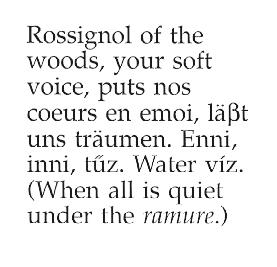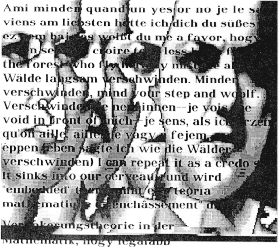
by Anne Tardos
Tsunami Editions
No. 6 - 1727 Williamson St.
Vancouver, B.C.
V5L 2R5 Canada
1992. $7.00.
Review by Karl Young
On the back of this book there is a statement that reads, in part, "Anne Tardos was born in Cannes, France, and grew up in Paris, moved to Budapest at the age of five, where she learned Hungarian, and at thirteen she moved to Vienna, where she learned German but went to a French high school. She has been living and working in New York since 1966. She found the four languages she knows . . . evenly present in her mind and often mixes them in poems." If I'm not mistaken, most people have one base language, and, if they're fortunate enough to know others, they make awkward transitions into the others, transitions that often involve rhymes, puns, malapropisms, and strange polyglot configurations. In speech, this can be amusing. When I attempt to speak French, it initially comes out with bits of Spanish, Latin, and Italian. I lived in Germany for a couple years as a child. I cannot consciously speak or read German. However, if I overhear people speaking German in some circumstance where I'm not trying to understand, I know what they're saying. If I then intentionally try to follow the conversation it becomes gibberish. I assume it's the same with most North Americans who are not fully multilingual.
There are probably few North Americans who read all four languages in which this book is written. In my case, English is my basic language; I don't have trouble with the French; have difficulty and need a dictionary for the German; while the Hungarian is completely opaque — even a dictionary would be of little use since my ignorance of Hungarian grammar is complete. But knowledge of all four languages is not necessary to appreciation of this book. Instead, the four languages act as difficulty levels between which the reader switches while reading. Passages in unintelligible languages act as a sort of sound poetry, and the text as a whole moves from clarity to complete abstraction at varying speeds. Here is a lyrical passage:

Tardos tends to make transitions on puns, on rhymes, on cognates false or true, and on words that more or less gloss each other. This can't help but create a playful base for the text. But Tardos can be deadly serious in places, as in the plea for vegetarianism that runs through the book and ends it in large and (for Anglophones) unambiguous terms.
Along with the text (sometimes covering parts of them) are images of Tardos herself, of her husband Jackson Mac Low, and of buildings visible from their loft. The self portraits were taken in a mirror some time ago. Through the book Tardos's face is a mirror image, while Mac Low's and those of buildings are not: in other words, all images are presented as Tardos would naturally see them in the course of a day. Tardos first video taped the images, then digitized and manipulated them with computer programs. The distortions introduced by Tardos make the images echo the work of other artists, including El Greco, Picasso, Duchamp, Leger, Ernst — perhaps you can even see a correlation between the computer pixels and other atomized forms, such as Seurat's pointillism. I don't know how many of these artists Tardos was thinking about when she did the images — a complete list compiled by her and any reader would probably not be identical. But this graphic translation is a mirror of the process of verbal resistance and transformation throughout the book. "Morte" can turn to "More" in much the same way as a Picasso frontal profile can face and draw significance from an Ernst-like frottage across an opening of the book. That "Morte" to "More" transition could be read as a playful detail or as a summary of the work as a whole.
Copyright © 1992 Karl Young

To go to a selection from Anne Tardos's Among Men in Grist On Line magazine # 6, press here.
Light and Dust @ Grist Mobile Anthology of Poetry.